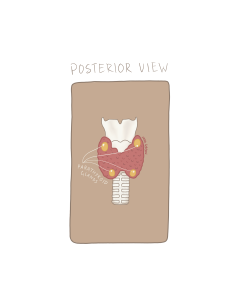20 Thyroid and Parathyroid
Thyroid:
Have you ever wondered how your body maintains a stable and comfortable temperature in extreme conditions, whether icy cold or scorching hot? This remarkable regulation is thanks to the butterfly shaped thyroid gland lying inferior to the larynx. It is composed of left and right lateral lobes on either side of the trachea connected by a bridging structure called the isthmus. It secretes many important hormones. Within the thyroid are microscopic thyroid follicles, consisting of:
- Follicular cells: form the lumen (internal space) which produce several hormones
- Basement membrane: surrounds each follicle

Figure 38 Anterior view of the thyroid gland
Thyroid hormones:
As shown above, follicular cells produce two hormones: thyroxine (T4) and triiodothyronine (T3). The number depicts the number of iodine atoms present in the hormone. Around 99% of T4 and T3 bind with a protein called thyroxine-binding globulin (TBG), which transports them through the bloodstream. Scattered between the follicular cells are parafollicular cells which produce a hormone called calcitonin. Calcitonin plays a role in maintaining calcium balance in the body. The basic functions of thyroid hormone (T3 and T4) are as follows:
- Increase basal metabolic rate (BMR), the rate of oxygen consumption under standard or basal (awake, at rest, and fasting) conditions.
- Stimulates synthesis of sodium-potassium ATPase pumps. The increased concentration of pumps leads to increased ATP usage and therefore increases the body temperature. Therefore, thyroid hormone plays key roles in maintaining body temperature especially in cold environments.
- Stimulate protein synthesis, and increase use of glucose or fatty acids.
- Enhances actions of some catecholamines (epinephrine, norepinephrine) leading to increased heart rate, and blood pressure.
- In conjunction with human growth hormone, thyroid hormone stimulates nervous and skeletal growth.

Figure 39 Thyroid(left) and Parathyroid (right) secretions
Thyroid Hormone homeostasis:
Like most – not all – hormones, T3 and T4 are regulated within a negative feedback loop which detects high levels of a hormone and subsequently inhibits the original stimulus to return to homeostasis:
- Low levels of T3 or T4, or low metabolic rate causes the hypothalamus to release TRH
- TRH enters the hypophyseal portal system and into the anterior pituitary to release TSH
- TSH stimulates various aspects of the thyroid to promote hormone synthesis and growth of follicular cells
- Thyroid follicles release T3 and T4 which in turn inhibit TRH and TSH release, thus returning thyroid hormone to homeostatic concentrations.
Figure 40 Thyroid negative feedback loop
Calcium homeostasis:
Calcium ions play a major role in several anatomical facets like muscle contraction, bone growth, nerve impulses and more. To ensure calcium remains in balance two hormones regulate its homeostasis: calcitonin and parathyroid hormones.
Calcitonin is a hormone produced from parafollicular cells which helps regulate the levels of calcium and phosphate in the blood, promoting the formation of bone and reducing the levels of calcium in the blood when they’re too high. Calcitonin also inhibits calcium release by inhibiting osteoclasts which break down bone tissue.
Calcitonin helps maintain calcium balance in the body by lowering calcium levels when they are too high. It promotes calcium storage in bones and reduces calcium absorption in the intestines and kidneys to restore balance.
Parathyroid hormone (PTH) opposes calcitonin through increasing blood calcium levels by breaking down bones via osteoclasts and increasing calcium absorption in the intestines and kidneys. PTH acts on bones as if they are banks of calcium which can be used to maintain proper calcium concentrations.
PTH is produced by chief cells (not those in the stomach), which are surrounded by large adipose cells within the parathyroid.
Parathyroid Glands:
The parathyroid glands are usually found in pairs on the back of the thyroid gland. Normally, they are where the main blood vessels enter the thyroid, but the lower pair can be found anywhere from the bottom of the thyroid to the upper chest area.
Blood supply to the parathyroid glands comes from the thyroid arteries, and the veins drain into the thyroid veins.

Figure 41 Posterior view of the parathyroid gland
Check out this meme about the thyroid!

Hint: This meme is referring to the fact that the lobes of the thyroid resembles the shape of a butterfly. This is why this character is wondering if the butterfly is a thyroid! Revisit the anatomy of the thyroid by clicking here.

